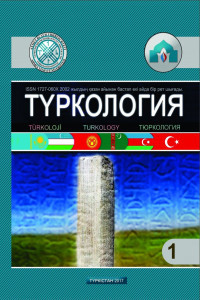HİSTORİCAL LAYERS OF THE NAME ANİMALS
The article considers the historical layers of animal names both in Kyrgyz and Turkish languages. The development of a common national language can be determined by the texts that contain the histoy of the nation. Historical data about Turkic languages and nations, as well as historical monuments not only determine the highlights of the development of the people, but also provide an opportunity to assess the phonetic, grammatical structure and lexical structure of language from ancient times to the present day.
There are many common words in Turkic and Mongolian languages with undetermined origin and it has been discussed for a long time in Turkic and Altaic studies. Therefore we can not assume any possibility of a revised etymology of certain words, which we know as the mandatory words with Mongolian origin.
Like other words of language, some name of animals can enter from other languages and enrich the vocabulary. Some words do not be plunged for any phonetic changes in borrowing. And some of them change sounds, and may differ from the initial shape. Such words meke dificulties in determining the root of word.
The names of animals which are the main object of this study also comprise several layers. As in Kyrgyz and Turkish languages it shows that the overpowering majority compose Arabic, Farska, Mongolian and European layers. Especially, many of the names of pets belong to the Mongolian layer. For example: zhylky (horse), uy (cow), koy (sheep), etc.
In two languages, different ways of moving words from European origin there are different conditions and it is the main indicator. If to Kyrgyz language words of European origin enters mainly through the Russian language, then in Turkish language such words are taken as a result of geographical, territorial proximity, due to close economic, political and social relations.
Part of the inflectional languages which related to Kyrgyz and Turkic languages, the words from European languages the word for semantic and etymological peculiarities, their influence on the Turkic nations are not the same, and it is defined once again in the course of this investigation. Adoption process in Kyrgyz and Turkic languages words from European languages are visible in the lexical composition of two languages in different conditions, especially their activation in XIX-XX centuries. It is the cause of scientific and technological progress, the impact of global, economic and political area, rather, as a result of above including the impact of globalization.
___
- Баскаков Н.А. (1969), Введение изучение тюркских языков. М:. -383с.
- Дыйканов К. (1980), Кыргыз тилинин тарыхынан. Ф: -156с.
- Номинханов Ц.Д. (1959), Термины животноводство в тюркских и монгольских языках. - Алма - Ата: Изд-во АН Каз. ССР,
- Орузбаева Б. (2004), Кыргыз тил илими (сборник статей). 2-том. Б:
- Садыков Т.(2010), Сагынбаева Б. Кыргыз жана түрк салыштырма грамматикасынын негиздери. Б: - 479 с.
- Санжеев Г.Д.К (1947), Тюрко-монгольской лингвистической проблеме // Тр. Моск. ин-та востоковед. М: -№4. с. 69.
- Щербак А.М. (1961). Названия домашних и диких животных в тюркских языках. - В кн.: Историческое развитие лексики тюркских языков. М:
- Юнусалиев Б.М. (1985), Тандалган эмгектер. Ф: 1985. –с. 510.
- ISSN: 1727-060X
- Başlangıç: 2002
- Yayıncı: Hoca Ahmet Yesevi Uluslararası Türk-Kazak Üniversitesi
Sayıdaki Diğer Makaleler
S.r. BORANBAEV, G. A. KOSHKAROVA, D.n. ABİEVA
THE COURSES OF THE SOLUT’ON OF THE MODERN KAZAKHS ES NATIONAL PROBLEMS
SIMILIARITIES OF TURKIC OLD RUNA WRITINGS WITH KAZAKH MANUSCRIPTS
A BRIEF HISTORY OF THE CITY IN THE LIGHT SIGANAK WRITTEN SOURCES
Bakhytzhan NURKHANOV, Mels BAKHTYBAYEV
İLK TÜRKMEN GENERAL VE KATILDIǦI TARIHÎ OLAYLAR
DIDACTICAL-PHILOSOPHICAL LITERATURE BY TRADITION IN THE POETRY OF ZHUSSIP YESHNIAZULY
DİVÂNU LUGÂTİ'T-TÜRK'TEKİ KIPÇAK SÖZ VARLIĞININ KAZAK TÜRKÇESİNDEKİ GÖRÜNÜMÜ
